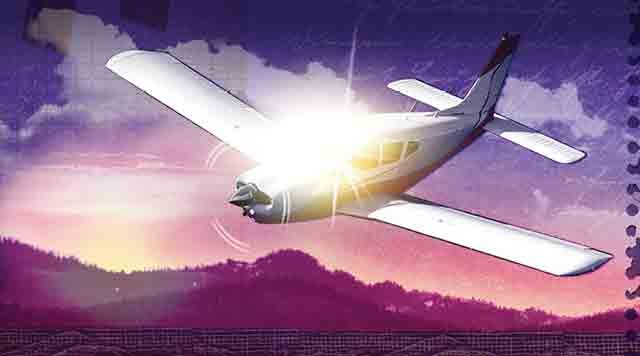
Illustration by Sarah Hanson
We’ve all known them: those impossibly fastidious aircraft owners who won’t (or can’t) tolerate the slightest trace of grime, oil, or moisture on their prized possessions. Every particle of insect remains must be removed from every surface, no matter how late the flight landed. The contents of each drawer of their tool chests are identified by labels that are both legible and accurate. All tires are inflated precisely to the correct pressures, and their hangar floors are cleaner than most people’s kitchen counters.
I am not one of those people.
I’m not talking about maintenance. I don’t compromise on the principle that everything on the aircraft should either work or not be there at all. But when it comes to cosmetics, well, paint doesn’t make the airplane fly. Those squashed bugs probably don’t cost me more than a knot or two in cruise. If my next flight also will be an animal rescue, it’s kind of a waste of time to vacuum the dog hair out of the cockpit in between. And not only am I too lazy to bother washing my own airplane, I don’t even have the decency to be ashamed of that.
However, a couple of years ago I attempted to mend my ways. An upcoming checkride persuaded me to pay the local FBO to wash my Piper Arrow, and the results were so impressive—people who have flown with me dozens of times actually asked whether I’d had it repainted—that I had them wax it, too. Thereafter I made some effort to conserve the results of all that hard work, spraying down the leading edges and scrubbing off expired invertebrates after every flight. (OK, every other.) I even splurged on a spray can of windshield cleaner from a well-known manufacturer I will not name because neither it nor its product was in any way responsible for what happened.
This stuff is almost miraculous. Spray it on, wait a moment, and then scrub with a cotton or microfiber towel. Insects and other detritus come off much faster than with water alone, but unless you go on polishing afterwards, it can leave a residue that’s difficult to see by the fluorescent lighting inside my hangar.
I found that out coming home from a fly-in in Delaware. I’d stayed longer than planned, finally leaving about 4 p.m. that November afternoon. This put me about 15 miles east of my home field in Frederick, Maryland, as the sun approached the horizon. The ATIS reported winds from 320 degrees at 11 knots gusting to 20, with Runway 30 in use.
As I made my initial call to the tower, the sun descended another degree—and my windshield lit up blazing gold. This didn’t just eliminate all forward vision; it was far too bright to even look in that direction. Apparently the overlooked cleaner residue was enough to create a refractive film. As I read back the instruction to report a three-mile final for Runway 30, I started thinking about how to land on a runway I couldn’t see. IFR procedures wouldn’t help, as there are no instrument approaches to 30, and the GPS would lead me to the airport reference point rather than the centerline.
For a VFR-only pilot, this could easily have become dangerous. Fortunately, I do hood work pretty regularly, and my allergy to morning means that at some point I’m usually flying westbound with the afternoon sun glazing my Foggles. I went onto instruments to keep the aircraft under control, staying a little high for obstacle clearance with occasional sideways glances to confirm my height above terrain. I also tuned the Runway 23 localizer into Nav 1, figuring that my best option might be to request that runway “for crosswind practice” and use the localizer to help nail down the centerline. (I’d landed in a 60-degree crosswind in Delaware, and the airplane was still usable.)
Luck is not a plan, but it shouldn’t be disparaged. As the GPS ticked down toward three miles and I reached for the push-to-talk switch, a cloud blocked the sun. I was about 50 feet left, high but not too high to land. I touched down and was on the taxiway before the sun took one last peek between the cloud and the ridgeline.
Sometimes you get lucky—but I know too well that sometimes you don’t. Now I check the windshield from inside the cockpit before I decide it’s clean.

